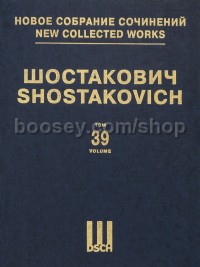Piano Concerto No 1. Op. 35. Piano score (New Collected Works vol.39)
Piano Concerto No 1. Op. 35. Piano score (New Collected Works vol.39)
* Estimated price converted from UK retail price
Click below to view music sample pages


Some believe that Shostakovich “immediately wrote the score of the concerto and then did the arrangement for two pianos”.Obviously, work on the score was going on at the same time as work on the rough drafts, and the composer orchestrated the fragments of the work already completed in the drafts before he finished the four-part composition in its entirety. It goes without saying that the piano score was completed after the score was finished. This possibly explains the fact that it was in the author’s manuscript of the piano score that the composer not only made a note documenting the date of completion, but also the date work on the composition began. It is worth noting that at first he placed both dates on the title page of the arrangement, but later, after crossing them out there, he wrote them at the end of the author’s manuscript.
There are significant differences intentionally made by Shostakovich in the solo piano part in the score and the author’s arrangement of the concerto. The composer introduced several inserts into the part of solo instrument in the arrangement of the concerto that supplement the second piano part in order to more fully reflect the score.
This publication is based on the author’s manuscript of the author’s piano arrangement kept in the fund of the Glinka State Central Museum of Musical Culture (SCMMC, rec. gr. 32, f. 41). When necessary, the text of the author’s manuscript was also collated with the author’s manuscript of the score, the lifetime editions of the score and piano score, and the volumes of Dmitri Shostakovich’s Collected Works (Muzyka Publishers, Moscow, 1982, 1983). Some clarifications are also taken into account, particularly those made in the 1982 and 1983 editions in keeping with the audio recording of the author’s performance of the concerto made in 1957.
All the author’s manuscripts presented in this Volume have never previously been a target of academic research, all the facsimiles of the author’s manuscripts are being published for the first time.
This ambitious series by DSCH, the exclusive publisher of the works of Dmitri Shostakovich, when complete, will run to 150 volumes.
Based on authentic manuscripts, accompanied by commentaries in Russian and in English, each volume contains new engravings, articles relating to the history of the compositions, facsimile pages of Shostakovich's manuscripts, outlines, and rough drafts.
Divided into 15 different "series" or genres, the edition will include nearly all the original works of the composer, and his instrumentation of music by Domenico Scarlatti, Beethoven, Schubert, Schumann, Mussorgsky, Rimsky-Korsakov, Johann Strauss, Youmans, Braga, Tishchenko, and others.
25% of the New Collected Works will be made up of previously unpublished material: over 80 of his works are being published here for the first time. Many of these previously unknown works could not be published or performed during the composer's lifetime for ideological reasons.
The fifteen "series" within the edition comprise:
I: Symphonies (vols 1-30)
II: Orchestra Compositions (vols 31-37)
III: Instrumental Concertos (vols 38-49)
IV: Compositions for the Stage (vols 50-67)
V: Suites from Operas and Ballets (vols 68-72)
VI: Compositions for Choir and Orchestra (With or Without Soloists) (vols 73-83)
VII: Unaccompanied Choral Compositions/Arrangements of Russian Folksongs (vols 84-86)
VIII: Compositions for Solo Voice(S) With Orchestra (vols 87-90)
IX: Chamber Compositions for Voice and Songs (vols 91-97)
X: Chamber Instrumental Ensembles (vols 98-105)
XI: Instrumental Sonatas(vols 106-108)
XII: Piano Compositions (vols 109-115)
XIII: Incidental Music (vols 116-121)
XIV: Film Music (vols 122-145)
XV: The Works of Other Composers, Instrumentation by Shostakovich (vols 146-150)




